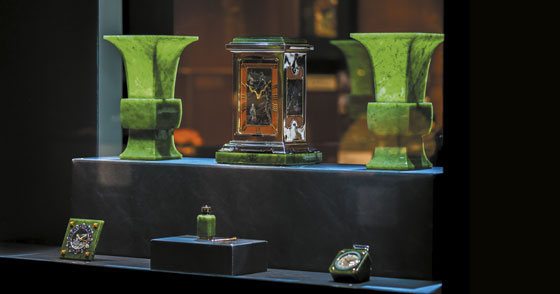
The Baur Foundation, a museum showcasing the arts of the Far East, and the House of Cartier have teamed up for the duration of an exhibition to create a sublime world of colour based on their rich collections.
While a museum and a watch and jewellery maker may not be obvious collaborators at first sight, they have organised an exhibition highlighting the influences of the Far East on objects and jewels from a bygone age.
The nineteenth and twentieth centuries witnessed the collection of «curios», so named because they stimulated the curiosity. These objects originating in China and Japan - enhanced with fanciful decorations, made from a variety of materials, some of which were little known in Europe - enthralled the West. They kindled a fad for Asia, beguiled art lovers and exerted a profound influence on graphic arts in Europe. This fascinating period inspired callings: in Alfred Baur (1865-1942) that of the collector, and in Alfred Cartier (1841-1925) and his three sons Louis (1875-1942), Pierre (1878-1964) and Jacques (1884-1941) that of the creator. Whereas Cartier’s Asian-inspired pieces are broadly known, their historical and cultural context is less so. Thus the idea arose to show these jewels alongside the collections of the Baur Foundation, Museum of Far Eastern Arts of Geneva.
As you wander through the rooms, as though on a treasure hunt, Asia Imagined gradually takes form. Pagodas and pavilions studded with diamonds, literati beneath a starry sky, nacreous moonlight, shimmering phoenixes, jade dragons, and colourful gems burgeoning like prunus blossom together depict an imaginary land. The Cartier magic exerts its magic. In the company of these creations, the imperial porcelain, lacquerware sprinkled with precious metals, embroidered silks, carved jade, coloured enamel, netsuke, sword fittings and prints that belong to the Baur Foundation tell their own story of fabulous China and Japan and establish a unique dialogue.
Alfred Baur, the collector
The uncertainty of life in nineteenth-century Switzerland prompted many citizens to leave. The insufficiency of agricultural produce and repeated industrial crises encouraged fathers, sons and sometimes entire families to try their luck elsewhere. Many went to America or Asia, where the opportunities for success seemed greater. Thus Alfred Baur embarked for the British Crown colony of Ceylon in 1884. While learning the basics of the import-export business, the young man discovered an endearing island and way of life. Gradually, his increasing experience opened new doors to him. He began to buy land for plantations, then successfully went into the business of making and selling natural fertilizer. In 1906, after having spent twenty-two years in Colombo, Baur returned to Switzerland from where he would continue to oversee his company.
Naturally curious and irresistibly drawn to Asia, Alfred Baur made his first purchases as a collector at the start of the twentieth century. He was initially interested by objects that were then in fashion and used to decorate pavilions at Universal Expositions. These were curios of different types: Satsuma porcelains painted with enamels and gold, sword fittings, sculptures in wood, ivory or bronze, prints, netsuke and Japanese lacquerware, semi-precious stones, brightly coloured cloisonnés, and Chinese snuff bottles. He was by preference attracted to small objects that could be stored easily in drawers but this logistical constraint only imposed itself for a short while. The long voyage to the East that he made with his wife in 1923-24 marked a turning point in the development of his personal taste. After leaving Ceylon, the couple visited India, China, Korea and then Japan. On his return to Switzerland, the exacting collector decisively purged his collection of fashionable objects with the aim of focusing his attention on works of exceptional quality. Very quickly Baur, who had no children, began to plan a future for his precious collections. He wished to protect his work and it was finally under the tutelage of a foundation that the museum existing today in Geneva was created.
Cartier, the jeweller
Cartier is above all the name of a dynasty of Parisian jewellers whose history began with a workshop bought up in 1847 and developed with the passing of the generations and vagaries of history. As a result of foresight and expertise, the Cartier company progressively won itself the custom of European aristocracy, then royalty, and eventually international high society. Later generations each added their contribution to the enterprise, adapting to the styles in vogue and demand, anticipating needs and stimulating new trends, all the while maintaining the marque’s exacting standards. Fairly early on, the company was no longer content simply to create magnificent jewels and launched out into the market of luxury goods. All sorts of precious objects were offered: watches and clocks, toiletries, desk accessories and articles for smokers, among others. The house of Cartier attempted to attract a cultivated clientele in search of elegance and novelty.
At the start of the twentieth century the fashion arose for travel, archaeology and everything from outside Europe, a development that was reflected in the inspiration of the Cartier brothers’ designs. The fabulous cultural treasures of Russia, Egypt, Persia, India and the Far East fascinated Western society with their exoticism and Cartier’s creations of this period exploited this allure. Asia Imagined was incorporated into the company’s repertoire of motifs.
Curiosity about the Far East had long begun to make itself felt at Cartier. Creations in Chinese and Japanese style are sporadically mentioned in the archive documents between 1877 and the early years of the twentieth century. But it was nonetheless necessary to wait until the Roaring Twenties for this recognition to develop into a true fashion. Henceforth, Asia would regularly make itself felt in the company’s creations. It influenced the design of jewels, timepieces and motifs, manifested itself in the manner in which certain materials were worked and was sometimes apparent in Art Deco stylization.
The exhibition «L’Asie rêvée» is open at the Fondation Baur, in Geneva, until 14th February 2016.
November 30, 2015


 News
News